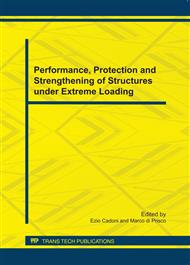[1]
American Society of Civil Engineers (ASCE). Report Card for America's Infrastructure, 2009.1801 Alexander Bell Drive, Reston, Virginia.
Google Scholar
[2]
Transportation Statistics Annual Report, U.S. Department of Transportation (USDOT), Bureau of Transportation Statistics, 2008.
Google Scholar
[3]
American Association of State Highway and Transportation Officials (AASHTO). Bridging the Gap. July 2008.
Google Scholar
[4]
Report of the National Surface Transportation Policy (NSTP) and Revenue Study Commission, Transportation for Tomorrow, December 2007 final report. Volume II, Chapter 4, p.6.
Google Scholar
[5]
Gangone, M.V, Whelan, M.J., Janoyan, K.D., and Jha, R. (2008). "Field deployment of a dense wireless sensor network for condition assessment of a bridge superstructure" SPIE Smart Structures Symposium, San Diego, California.
DOI: 10.1117/12.776604
Google Scholar
[6]
Tsai-Wei Wu; Hung-Yun Hsieh, "Interworking Wireless Mesh Networks: Performance Characterization and Perspectives," Global Telecommunications Conference, 2007. GLOBECOM '07 IEEE, ISBN: 978-1-4244-1043-9, pp.4846-4851, Nov. 2007.
DOI: 10.1109/glocom.2007.919
Google Scholar
[7]
Tehuang Liu; Wanjiun Liao, "Location-Dependent Throughput and Delay in Wireless Mesh Networks," Vehicular Technology, IEEE Transactions on , vol.57, no.2, pp.1188-1198, March 2008.
DOI: 10.1109/tvt.2007.905389
Google Scholar
[8]
Siddiqui, Muhammad Shoaib; Amin, Syed Obaid; Hong, Choong Seon, "An Efficient Mechanism for Network Management in Wireless Mesh Network," Advanced Communication Technology, 2008. ICACT 2008. 10th International Conference, vol.1, pp.301-305, Feb. 2008.
DOI: 10.1109/icact.2008.4493766
Google Scholar
[9]
Sohn, H, and Farrar, C. R. (2001). "Damage Diagnosis using Time Series Analysis of Vibration Signals," Smart Materials and Structures; Institute of Physics, vol. 10, pp.1-6.
DOI: 10.1088/0964-1726/10/3/304
Google Scholar
[10]
Kato, M, and Shimada, S. (1986). "Vibration of PC Bridge During Failure Process," Journal of Structural Engineering, ASCE 112(7), pp.1692-1703.
DOI: 10.1061/(asce)0733-9445(1986)112:7(1692)
Google Scholar
[11]
Farrar, C. R., Baker, W. E., Bell, T. M., Cone, K. M., Darling, T. W., Duffey, T. A., Eklund, A., and Migliori, A. (1994). "Dynamic Characterization and Damage Detection in the I-40 Bridge over the Rio Grande," Technical Report LA-12767-MS, Los Alamos National Laboratory, June, 153p.
DOI: 10.2172/10158042
Google Scholar


